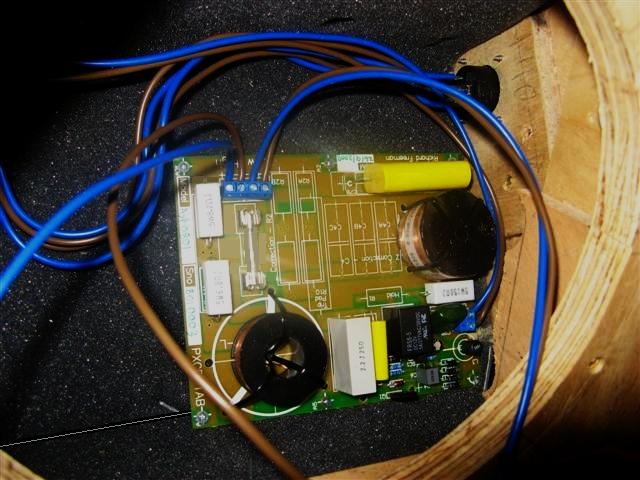Compact Wedge Part 2 - Assembly
and painting
Assembly
Having assembled the
two Side plates we are now ready to assemble the rest of the wedge
The
rear baffles (for want of a better name) A, B, C and D fit around the
Sub plates as shown below, you may want to put off gluing the pieces
together until you have made sure they all fit nicely.
Note
that you will need to cut a couple of pieces of wood from the angled
lengths O and P for mounting the front Baffle.
While gluing, make
sure joins between the rear baffles are Glued well by running a bead of
glue between them as all joins need to be air tight:
Make sure that
the screws are driven well into the wood, confirm that the handle is
comfortable (sand down any sharp or rough edges) and give the glue
time to dry (24 Hours is good).
Fill all Screw holes, any
imperfections and any gaps with filler (I used Selleys Plastic
wood) and allow to dry.
Sand the wedge/wedges down - if you are
merely twice as good at woodwork as me (I am not very good at all) then
you will find that the neatness of the resulting wedge is largely
dependant on how well you fill and sand.
Before we start
with the painting it is a good idea to make up a stand that the wedge can
sit on while being painted and while drying- I made mine up with scraps of
wood lying about (Right hand picture above).
Mix up the liquid Epoxy
Resin as per the instructions adding a dessert spoonful of Lamp black
(if the wedges are to be painted black) I found that 4 x 30mL
measuring cups of both the Resin and Hardener (i.e. 240ml total) was
enough to do two wedges.
Using a throwaway brush (I found cleaning
brushes of epoxy resin to be fiddly and time-consuming and I could get
cheap natural fibre brushes for less than $2 each (NOTE Plastic bristles
will melt) start painting the front rim of the foldback wedge,
let the first coat soak well in and then apply a second and third etc
until no more soaks in Stir the epoxy and lamp black regularly as you
paint.
When you have
finished the front rim of the wedge place the wedge face down on the stand
and start painting all the edges and around the handle etc again paint
these well - when you have finished protecting all the corners and edges
use the remaining resin to paint the rest of the wedge.
Timing
for the paint may vary according to the Resin you use but is usually
half the cure time for the resin (check the instructions
for your Epoxy Resin).
I used Dulux enamel to provide the top
coats and this has (so far) turned out to be reasonably durable Rockard is
also worth using.
Build up the paint good and thick to get a smooth
finish - if you have access to a spray gun that would be good. Note be
careful not to get any paint in the thread of the T nuts for the stand
mount.
Line the inside of the wedge with foam and mount the crossover - Note that it fits best
mounted at the front of the wedge next to the stand mount with
the Relay towards the front (as per the pictures below) for it
to clear the speaker.
Solder wires to one of the Speakon connectors
making sure that the wires to the other connector are long enough to reach
through the mounting hole on the other side of the wedge. Mount the
connector using self tapping countersunk screws, pull the wires through
the opposite hole and solder them to the other connector. Mount and screw
in the other connector and connect to the crossover.
Line up the
front baffle and spacer and screw them together - check that these fit the
front of the wedge and plane the edges back as required.
Mount the front
Baffle and Front spacer and trim mesh to fit the front of the wedge.
I managed to find a countersunk screw that neatly fitted the holes
in the mesh.
Note that I have since found that the grill may loosen
over time causing a rattle, so it is a good idea to use a piece of felt or
foam rubber (not shown in the pictures above) behind the grill to dampen
any rattles.
Connect up and mount the speaker - Remember that the
tweeter is connected out of phase according to the markings on the
crossover.
Stick Velcro strips around each edge of the mesh as
this is used to hold the Speaker foam (also sold as Air conditioning
Filter) in place.
Your wedge is now complete and
ready for use.
Kit
costs $xx (Australian) and includes:
PCB
Assembly
instructions
Email
for more details or Paypal instructions (to order) - note at this stage I
will have to work out mail costs on a case by case
basis...
Copyright © 2011 Australian Technical Production
Services
|
















.jpg)
.jpg)